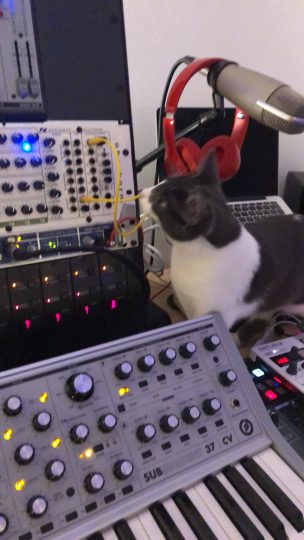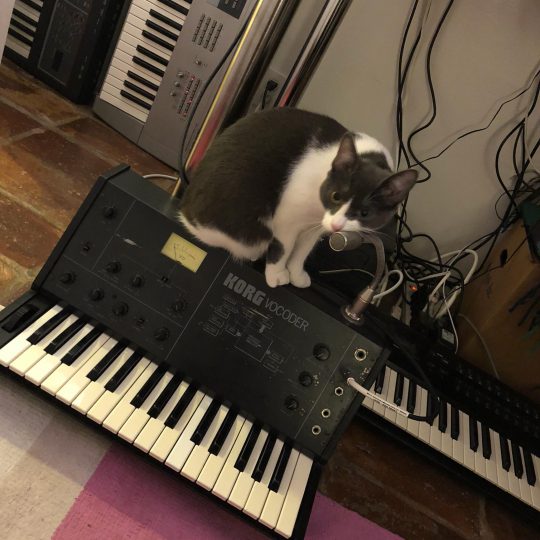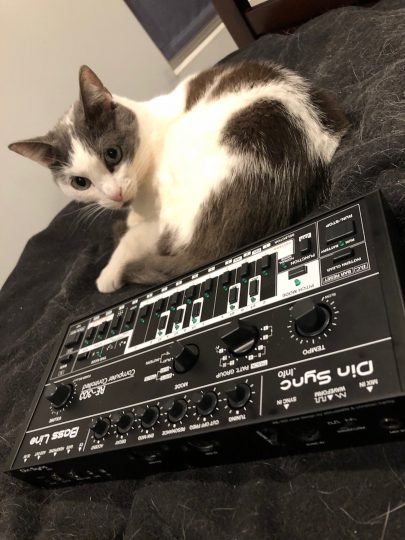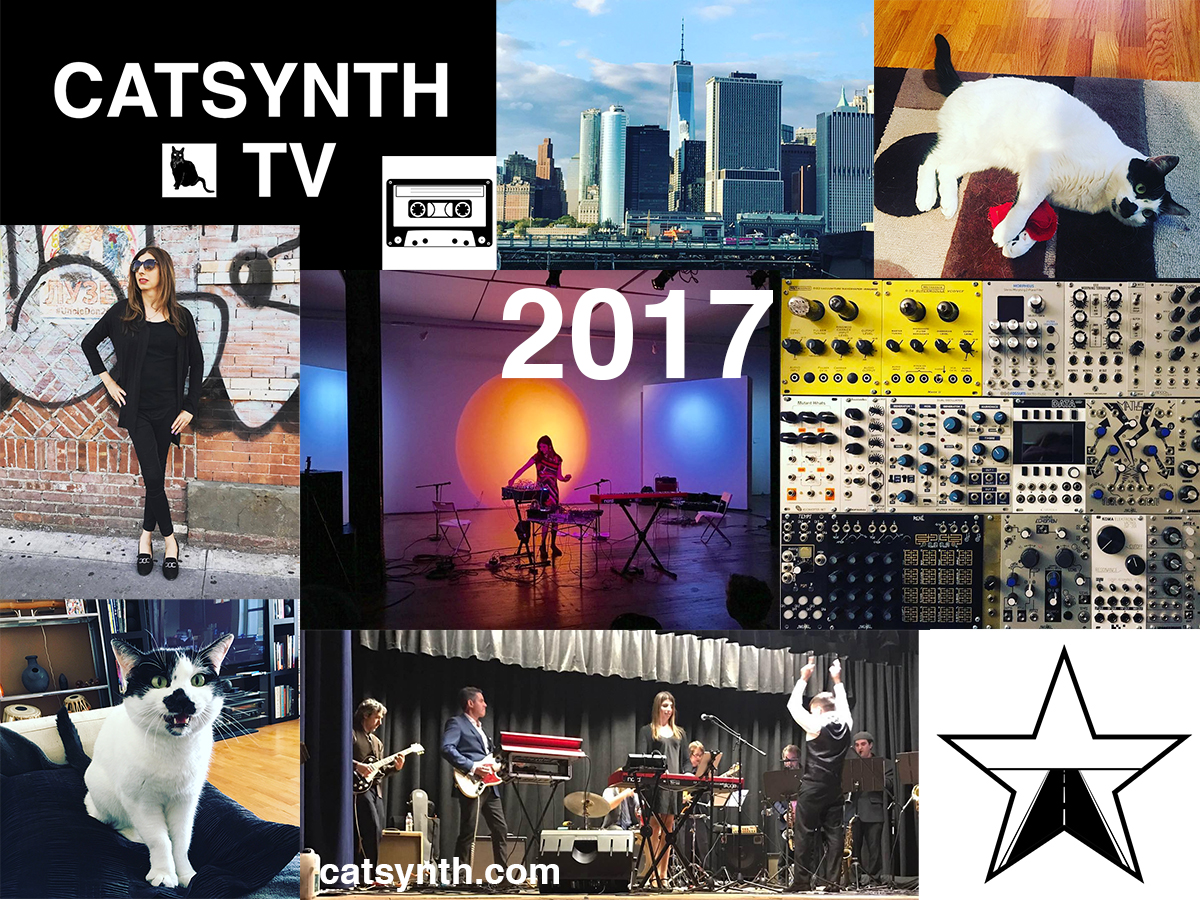
Gracie returns, this time with a Moog Subsequent 37. Though she does seem more interested in the Eurorack modules behind it 😸
“Hmmm. Analog …”
From Alsún Ní Chasaide via our Facebook page.


Gracie returns, this time with a Moog Subsequent 37. Though she does seem more interested in the Eurorack modules behind it 😸
“Hmmm. Analog …”
From Alsún Ní Chasaide via our Facebook page.

From Alsún Ní Chasaide on the Facebook group Synthesizer Freaks.
Like I spent weeks restoring this & she can’t wait to get on it. If vocoders aren’t for sits, then why are they made of warm?
We at CatSynth had the opportunity to play with a Korg VC10 vocoder last year. It is indeed made of warm, as are most analog vocoders 😸. It also had a bit of the Korg grit that characterizes their vintage instruments, and best of all it allowed for external carrier signals (this is something I wish was easier to do on the Roland VP-03).
That most wonderful time of year known as NAMM is fast approaching! As we prepare to cover this year’s show, we’re sharing some of our past NAMM videos on CatSynth TV!
This year’s show starts on January 25. Please let us know in these posts about anything specific you would like us to investigate or review while we are there.

Our pal Mister Kitty returns to the pages of CatSynth with his new RE-303 bass synthesizer.

The RE-303 is a replica of the infamous Roland TB-303. This one was assembled by Mister Kitty’s human, Prophei (aka Michael Dietel). We at CatSynth approve of their choice of the black case. Oh, and it sounds great, too.
As a replica, the circuit board and CPU are compatible with the original TB-303, which suggests the parts can be used to refurbish vintage instruments in addition to building new ones. You can read a bit more in this Synthopia article from 2015. Clearly, the statement about DIY kits turned out to be wrong, as evidenced by this article. You can find out more about the RE-303 and kits here.

Meanwhile, we wonder what Mister Kitty may have in store for us next…

Once again, it is time for our end-of-year collage and review. So many images to choose from in such a busy 2017 that took us in so many directions at once, both outward and inward.
At the end of 2016, I was still reeling from the loss of Luna and the election. But I did welcome Sam Sam into my life and also promised myself that I would prosper and thrive in the new terrifying Trump era. And we did, focusing on moving forward with the things from 2016 that did go well. Lots of new music as a solo performer, with my new band CDP, and with Vacuum Tree Head. There are now three CatSynth-branded apps for both iOS and Android, and a fourth on the way. We launched CatSynth TV, with 22 videos under our belt since October. And Sam Sam has blossomed into a sassy and thoroughly spoiled cat whom we love dearly.
If there is a word of caution on the personal and professional fronts, it is perhaps that 2017 was too much. After a strong first half of the year through July, I scaled back on live performance to focus on other priorities. I regret that, but it was also the reality of the many things going on. I wish the apps, blog, and video channels were progressing faster, but it’s as fast as we can go with our myriad other responsibilities. The last couple months, while still rich with experience, have been an exercise in paring back and trying to focus on the highest priorities; and also focus on health, self-care, and well being. These are all very challenging, but I’m grateful to have the help of loved ones.
We cannot ignore the fact that our rebound in 2017 after two difficult years took place amidst a dark pall over the country and world. Many friends have suffered amidst the monumental forces of hurricanes, flooding, fires, and human foolishness. The latter is most visible in the face of the current regime that continues to embarrass and threaten us. These are things we have to be vigilant about as we move in 2018. I do feel personally in the cross-hairs on multiple fronts, so I hope we can continue to survive and prosper as well as we did in 2017, and maybe at the end of 2018 we will look back and saw how the world became at least a slightly better place.
It is also interesting to look back to our end-of-year post from 2007, ten years ago. It was a dark, cold time amidst major life changes – I couldn’t have imagined then what life would be like now. Will we feel the same way in 2027? And will there still be a CatSynth then? Only time will tell…
From Andor Polgar on YouTube, via matrixsynth. Rhodes, Make Noise Morphagene and cat, what is not to love?
Things used in the video: vegan sausage for taming the cat (that’s her favorite), Make Noise Morphagene eurorack module, Rhodes Mark I electric piano, Expert Sleepers Disting mk4 for the reverb effect.
http://andor.cool
https://instagram.com/andorgram
It may be time to experiment again here at HQ with the Nord and some Make Noise modules…
Our latest CatSynth TV documents yesterday’s edition of inWooble, a monthly synthesizer meetup and jam session at LinkedIn’s offices in downtown San Francisco. I had the opportunity to join this time, and had a good time performing with everyone – I particularly enjoyed the time where we were rhythmically together or forming complex contrapuntal textures across the six modular-synthesizer setups. And the views of downtown SF out the window were pretty cool, too.
Hosts:
Franck Martin
Juan Rosales
Bryan Levay
Participants:
M.0 (Maurice Jackson)
Amanda Chaudhary
Chris Otchy
The Facebook live stream from the event can be found https://www.facebook.com/franck.martin.music/videos/1921164038148996/
Recently, John Lee, the creator of bayimproviser.com donated a portion of his extensive record collection to Outsound. And our friends at VAMP are helping us sell them to fund our continuing mission of promoting new music in the Bay Area and beyond. To launch this effort, Outsound held a benefit concert at VAMP on December 1.
I performed a solo set with my trusty Nord Stage EX, modular synth, and Casio SK-1.

As with most of my current solo performances, I try to combine both idiomatic jazz and funk elements with more experimental electronics. I opened with White Wine (instrumental) with the extended solo section morphing into a more free-form electro-acoustic improvisation that also included the garrahand drum. It moved from sections of disco and bossa nova rhythms to noise to complex harmonies from the drum and Make Noise Echopon module. It was a fun set with an appreciative audience of both attendees and record-store patrons.

After my set, Tri-Cornered Tent Show took stage. Anchored by bandleader Philip Everett on clarinet and electronics and Ray Schaeffer on bass, the band explored a variety of sounds and styles from noisy electronics and percussion to R&B grooves to psychedelic serenades featuring Valentina O on vocals. Anthony Flores rounded out the band on drums.

It was interesting to see how both sets explored the intersection of avant-garde electronic and acoustic sounds with more familiar idioms. Soul, funk, and R&B were present in both sets, but then we each veered off in different directions. Between us, we might have covered many of the genres in VAMP’s record bins!
It was a fine night of music and fellowship, and it’s great to see an independent (and idiosyncratic) store like VAMP flourishing in downtown Oakland. You can find out more about them here. And please visit Outsound’s website to find out about upcoming programs and how you can help support our work bring new music to our community.

Just a cat in the studio with a large modular synthesizer collection. Identification of modules left as an exercise to the reader 😺
From Rik Simpson on Instagram.

Cute calico cat sitting atop a Korg MS-20 synthesizer (or at least we are pretty sure it’s an MS-20).
gunceaci . 10M ago
Sunday mood #patchmeup #catsynthesizer